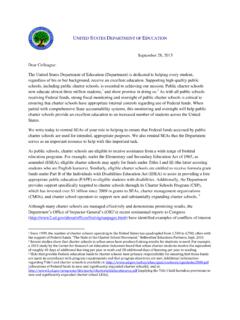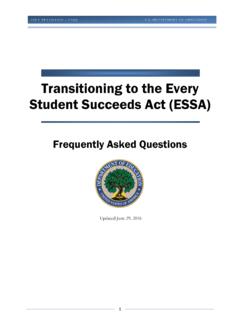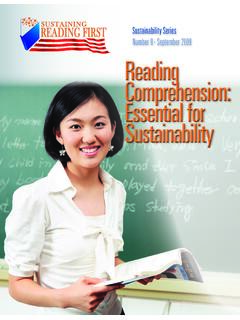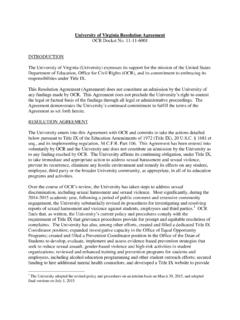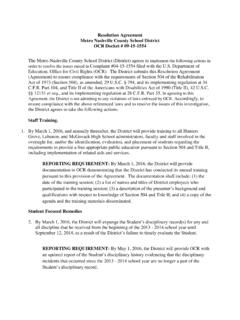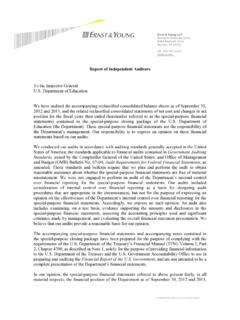Transcription of Social and Emotional Development Research Background
1 Social and Emotional Development Research BackgroundSharing, making friends, paying attention, expressing emotions, and dealing with challenges successfully are critical to lifelong learning, success, and happiness. These skills are part of Social and Emotional Development , which begins with children s earliest relationships and experiences and has big impacts on later outcomes not just for children, but for their families and communities, too! Social and Emotional Development involves several interrelated areas of Development , including Social interaction, Emotional awareness, and self-regulation. Below are examples of important aspects of Social and Emotional Development for young interaction focuses on the relationships we share with others, including relationships with adults and peers. As children develop socially, they learn to take turns, help their friends, play together, and cooperate with others. Emotional awareness includes the ability to recognize and understand our own feelings and actions and those of other people, and how our own feelings and actions affect ourselves and is the ability to express thoughts, feelings and behaviors in socially appropriate ways.
2 Learning to calm down when angry or excited and persisting at difficult tasks are examples of and Emotional Development begins in the earliest moments. Infants learn through Social interactions with the adults who care for them and most are born with the ability to read basic Social For example, in the first hours of life, infants turn their heads toward their parents Later in infancy, most babies learn to look to where adults are looking or pointing and then begin imitating simple actions and sounds during interactions with For some children with developmental delays or disabilities, milestones may come a little later or children may need extra support to enhance their Social and Emotional Development . Supporting all young children s early Social interactions helps them begin to understand their world and open the door for the earliest learning experiences. Children with a strong Social and Emotional foundation are more likely to graduate high school, go to college, and fare better on measures of overall , 5 What the Research Tells UsThe relationship between children, their families, and other adults in their lives is critical to children s healthy Social and Emotional , 7, 8 Beginning from birth, parents and caregivers play a central role in fostering Social and Emotional Development by responding sensitively and consistently to the needs of their infants.
3 When families and caregivers provide consistent and warm care, read their infant s cues, and engage in meaningful back-and-forth interactions, they show children that they are loved and secure. This security gives young children the confidence they need to explore the world around them, discover new concepts, and form positive relationships with others like peers and teachers. As children grow, families, caregivers, and early childhood teachers can support children s emerging Social and Emotional Development by continuing to foster warm and responsive relationships. Within the safe havens of close relationships, children can learn new and more complex skills, like self-regulation, playing with peers, and empathizing with others. These and other dimensions of Social and Emotional Development prepare children for success in school and set the foundation for health and wellness later in life. For some children with developmental delays or disabilities, more intentional and intensive supports may be In these cases, parents can partner with professionals, such as early interventionists and special educators, to support children s Social and Emotional growth.
4 All children have the ability to experience emotion, but how they experience it and how they learn to manage it may depend a great deal on the relationship with their primary caregiver(s) and other important adults in their lives, and the early learning environments where they spend their ,11A large body of Research shows that a strong Social and Emotional foundation helps boost children s learning, academic performance and other positive long-term outcomes. Frequent back-and-forth interactions with caregivers in the earliest years form the foundation of Social and Emotional Development and Development in all areas. These interactions create neural connections in the brain that are the building blocks of later , 13 When children are able to manage their emotions, get along well with others, and persevere through challenges, their minds are free to concentrate on learning new things from parents, teachers, peers, and through their own exploration.
5 Children with a strong Social and Emotional base tend to be more engaged in learning and form relationships with others more For example, when children play collaboratively with peers, they can share what they know, learn from others, and advance their learning. Learning from peers is important for all children, but can be especially important for some children with developmental disabilities and delays. A robust body of Research indicates that structured peer-mediated learning has strong effects on academic, interpersonal, and Social Development for children with developmental , 16, 17 Strong Social and Emotional skills can also boost motivation, perseverance, and self-regulation critical skills for academic and lifelong In fact, Research shows that children who enter kindergarten with good Social and Emotional skills may be more likely to attend college, earn a degree, and enjoy stable employment prospects later in Furthermore, strong Social and Emotional skills at kindergarten entry help lower children s risk of mental health problems in These compelling outcomes underscore the importance of focusing on Social and Emotional Development for all children, including those with and without disabilities and developmental Social and Emotional Development carries important benefits for all children.
6 And particularly for children from low-income families and young children with developmental delays or disabilities who may start school behind their , 22, 23 Opportunities to foster Social and Emotional Development are all around us. Families and caregivers can nurture children s Social and Emotional Development through simple, daily activities. For example, when caregivers provide predictable daily routines, they help children develop trust and feel safe and in control. Similarly, helping children stay calm and focus on a task develops critical self-regulation skills that they ll use to tackle future additional resources on supporting Social and Emotional Development in young children, check out the other resources in this resource materials are provided for the user s convenience. The inclusion of these materials is not intended to reflect its importance, nor is it intended to endorse any views expressed, or products or services offered.
7 These materials may contain the views and recommendations of various subject matter experts as well as hypertext links, contact addresses and websites to information created and maintained by other public and private organizations. The opinions expressed in any of these materials do not necessarily reflect the positions or policies of the Department of Education. The Department of Education does not control or guarantee the accuracy, relevance, timeliness, or completeness of any outside information included in these Brazelton, T. B. & Cramer, (1991): The Earliest relationship : Parents, Infants and the Drama of Early Attachment. Accessed at Ibid3. Ibid4. Robert Wood Johnson Foundation (2015). How Children s Social Competence Impacts their Well-being in Adulthood. Available online: Jones, Damon E., Mark Greenberg, and Max Crowley. (2015). Early Social - Emotional functioning and public health: The relationship between kindergarten Social competence and future wellness .
8 American Journal Public Health, 105(11), 2283 Brazelton, T. B. & Cramer, (1991): The Earliest relationship : Parents, Infants and the Drama of Early Attachment. Accessed at Cassidy, J. (2008). The nature of the child s ties. In J. Cassidy & P. R. Shaver (Eds.), Handbook of attachment: Theory, Research , and clinical applications (2nd ed.). New York: Guilford John Bowlby, Attachment and Loss (New York: Basic Books, 1980).9. Fox, L. & Smith, B. (2007). Issue Brief: Promoting Social , Emotional , and behavioral outcomes of young children served under IDEA. Challenging Behavior, Retrived November 24, 2014 from Cassidy, J. (2008). The nature of the child s ties. In J. Cassidy & P. R. Shaver (Eds.), Handbook of attachment: Theory, Research , and clinical applications (2nd ed.). New York: Guilford Publications11. Durlak, J. A., Weissberg, R. P., Dymnicki, A. B., Taylor, R. D., & Schellinger, K. B. (2011). The impact of enhancing students Social and Emotional learning: A meta analysis of school based universal interventions.
9 Child Development , 82(1), National Scientific Council on the Developing Child (2004). Children s Emotional Development Is Built into the Architecture of Their Brains: Working Paper No. 2. Retrieved from 13. National Scientific Council on the Developing Child. Key Concepts of Brain Architecture. Available online: Payton, J., Weissberg, R. P., Durlak, J. A., Dymnicki, A. B., Taylor, R. D., Schellinger, K. B., & Pachan, M. (2008). The Positive Impact of Social and Emotional Learning for Kindergarten to Eighth-Grade Students: Findings from Three Scientific Reviews. Technical Report. Collaborative for Academic, Social , and Emotional Learning (NJ1).15. DiSalvo, C. A., & Oswald, D. P. (2002). Peer-mediated interventions to increase the Social interaction of children with autism: Consideration of peer expectancies. Focus on Autism and Other Developmental Disabilities, 17, McMaster, K. L., Fuchs, D., & Fuchs, L. S. (2006).
10 Research on peer- assisted learning strategies: The promise and limitations of peer-mediated instruction. Reading & Writing Quarterly, 22, 17. Bass, J. D., & Mulick, J. A. (2007). Social play skill enhancement of children with autism using peers and siblings as therapists. Psychology in the Schools, 44, Brackett, M & Rivers, S.(in press). Transforming Students Lives with Social and Emotional Learning. To appear in the Handbook of Emotions in Education Yale Center for Emotional Intelligence. Available online: Damon E. Jones and others, Early Social - Emotional Functioning and Public Health: The relationship between Kindergarten Social Competence and Future wellness , American Journal of Public Health 105(11) (2015): 2283-2290. 20. Terrie E. Moffitt and others, A gradient of childhood self-control predicts health, wealth, and public safety, PNAS 108(7) (2010): 2693-2698 21. Duncan, G. J., & Magnuson, K. A. (2011).
